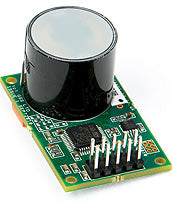
Altitude makes a difference when you are measuring CO2 levels. CO2 sensor modules are calibrated at sea level, and are not designed to automatically compensate for higher altitudes.
CO2 sensors need either a manual offset using a barometer or lookup table for altitude compensation, or a built-in barometric pressure sensor to automatically compensate for the change.
Altitude Compensation: Identifying the Problem
A customer called recently and said we had sold him a defective CO2 sensor module. He had calibrated it precisely at 0.0ppm (zero parts-per-million), took it outside, and the sensor read 335ppm.
“Where do you live?” we asked.
“Colorado,” he replied.
It took a few minutes to explain, but in the end the customer understood that altitude makes a difference when you are measuring carbon dioxide levels. CO2 sensor modules are calibrated at sea level. Most are not designed to automatically compensate for changes to CO2 at higher altitudes.
Atmospheric Pressure and CO2
When you think about altitude, it helps to imagine a vertical column of air rising from the earth’s surface to the outer limits of the atmosphere. The gas molecules in air have weight. The weight is heaviest at the earth’s surface, but becomes lighter as you measure it higher up the vertical column. At the top of the column, the weight becomes zero.

When talking about the “weight of air” scientists use the term atmospheric pressure. AP is typically measured in hectopascals (hPa), inches of mercury (inHg), or millimeters of mercury (mmHg). At sea level, these are as follows:
- 1,013.25 hPa
- 29.921 inHg
- 760 mmHg
As you go higher in the atmosphere, each of these numbers get smaller. So to correct for atmospheric pressure when measuring CO2 levels, you simply divide the atmospheric pressure at sea level by the atmospheric pressure where you take the CO2 measurement. It doesn’t matter which scale you use; the answer will always be the same ratio. Multiply this fraction by the CO2 measurement at sea level, and you have the new CO2 level at any altitude.
Here’s an example.
The city of Denver, Colorado is approximately 5,000 feet above sea level. At this altitude, the atmospheric pressure is 632 mmHg (barometric pressure table). A CO2 sensor calibrated at 400ppm at sea level would read 400(623/760) or 332ppm.
Here at CO2Meter, our rule of thumb is that the CO2 level at altitude will change about 3% for every 1,000 feet (300m). At 5,000 feet, that would be 400ppm less 15%, or about 340ppm.
This type of correction can have real-world consequences. For example, suppose a grower in Denver wanted to maintain exactly 1,000ppm CO2 in their greenhouse. In order to achieve this, they would have to set the sensor to 15% above 1,000ppm, or about 1,150ppm.
Note that while CO2 sensor modules do not automatically account for changes in altitude from sea level, they can be recalibrated for this. And some CO2 meters have built-in barometers that can compensate in real time. So if you are at high altitudes and need extremely accurate CO2 level readings, you should look for these features before making a purchase.
Altitude Compensation for Oxygen Sensors
Like CO2 sensors, oxygen sensors also require pressure temperature compensation. The 21.9% oxygen level commonly stated assumes STP, or standard temperature and pressure. Go to Colorado and the oxygen level is 17.3%. Here's a handy chart to show you the differences. Before purchasing an oxygen sensor check whether it is automatically compensated for pressure with a barometric pressure sensor on-board, or if you will need to adjust the oxygen level either by a lookup table or with a separate barometric pressure sensor.
If you need assistance choosing the correct sensor for your application email us or call us at (877) 678-4259. We'll be happy to answer any of your questions.








